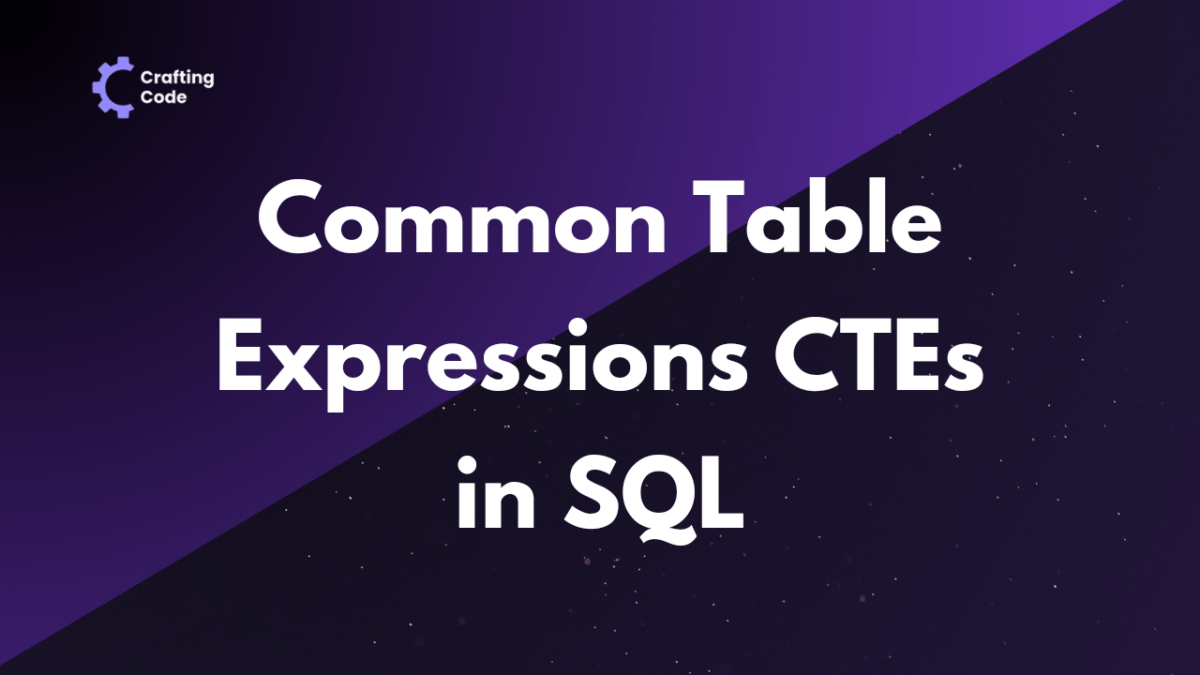Common Table Expressions, commonly referred to as CTEs, are a powerful feature in SQL that allow you to define temporary result sets within a query. Essentially, they enable you to break down complex queries into more manageable and logical parts.
Instead of embedding subqueries directly within the main query, CTEs provide a cleaner and more readable way to organize and structure your SQL code. They are particularly useful for tasks such as recursive queries and data transformation.
Imagine you have a query that involves multiple levels of aggregation or complex joins. With CTEs, you can define intermediary result sets, making it easier to understand and debug your SQL code.
Advantages of using CTEs in SQL
Now, let’s talk about why CTEs are so valuable in SQL development:
- Readability: CTEs enhance the readability of your SQL code by breaking down complex queries into smaller, more understandable parts. This makes it easier for you and other developers to maintain and troubleshoot the codebase.
- Reusability: CTEs allow you to define a subquery once and reference it multiple times within the same query. This reduces redundancy and can improve query performance by avoiding repetitive calculations.
- Recursive Queries: CTEs support recursive queries, which are essential for working with hierarchical or recursive data structures. This includes tasks such as navigating organizational charts, analyzing bill of materials, or traversing tree-like data structures.
- Data Transformation: CTEs can be used for data transformation tasks such as pivot operations, unpivoting, and performing complex calculations. They provide a flexible and efficient way to manipulate data within a single SQL statement.
Syntax and Implementation of Common Table Expressions
Here is how you can Create a CTE in SQL:
- Define your CTE using the “WITH” keyword followed by a name and a query.
- Structure your CTE query to select, join, or manipulate data as needed.
- Reference the CTE within your main query by simply using its name.
- Utilize CTEs for tasks like recursive queries, data transformation, or simplifying complex logic.
- Ensure clarity and readability by organizing your SQL code effectively with CTEs.
Basic syntax and structure of CTEs
In SQL, Common Table Expressions (CTEs) are defined using the WITH keyword, followed by the CTE name and its corresponding query enclosed in parentheses. Here’s a basic example:
WITH CTE_Name AS (
-- CTE query goes here
SELECT column1, column2
FROM your_table
WHERE condition
)
Declaration and usage of CTEs in SQL queries
Once defined, you can reference the CTE within the main query. This allows for a more modular approach to SQL queries, enhancing readability and maintainability. Here’s how you use a CTE in a query:
WITH CTE_Name AS (
-- CTE query
)
SELECT *
FROM CTE_Name
WHERE condition;
Example:
Let’s check a practical example to understand CTEs better. Consider a scenario where you want to find employees with salaries greater than the average salary:
WITH Above_Avg_Salary AS (
SELECT *
FROM employees
WHERE salary > (SELECT AVG(salary) FROM employees)
)
SELECT *
FROM Above_Avg_Salary;
In this example, Above_Avg_Salary is the name of our CTE. We’re selecting all columns from the employees table where the salary is greater than the average salary. Then, we select all records from the Above_Avg_Salary CTE.
Practical Applications of Common Table Expressions
Recursive Queries: Exploring hierarchical data with CTEs
When dealing with hierarchical data structures like organizational charts or file systems, recursive queries become invaluable. Let’s explore how CTEs simplify these complex tasks:
WITH RecursiveCTE AS (
-- Anchor member
SELECT employee_id, employee_name, manager_id
FROM employees
WHERE manager_id IS NULL
UNION ALL
-- Recursive member
SELECT e.employee_id, e.employee_name, e.manager_id
FROM employees e
INNER JOIN RecursiveCTE r ON e.manager_id = r.employee_id
)
SELECT *
FROM RecursiveCTE;
In this example, the RecursiveCTE recursively selects employees and their managers, starting from those without managers (manager_id IS NULL) and then iterating over each level of the hierarchy until all related records are retrieved.
Data Transformation: Performing complex data manipulations using CTEs
CTEs are also handy for transforming data, whether it involves pivoting, unpivoting, or aggregating information. Let’s see how we can simplify such tasks:
WITH SalesData AS (
SELECT DATE_TRUNC('month', order_date) AS month,
product_category,
SUM(sales_amount) AS total_sales
FROM orders
GROUP BY DATE_TRUNC('month', order_date), product_category
)
SELECT *
FROM SalesData;
Here, the SalesData CTE aggregates sales data by month and product category, making it easier to analyze trends and patterns over time.
Improving Query Readability and Maintainability with CTEs
Beyond specific tasks, CTEs enhance the overall readability and maintainability of your SQL code. Consider the following example:
WITH CustomersInHighRevenueRegions AS (
SELECT customer_id
FROM orders
WHERE order_amount > 10000
GROUP BY customer_id
),
HighValueCustomers AS (
SELECT customer_id, SUM(order_amount) AS total_amount
FROM orders
GROUP BY customer_id
HAVING SUM(order_amount) > 50000
)
SELECT *
FROM HighValueCustomers hvc
JOIN CustomersInHighRevenueRegions cirr ON hvc.customer_id = cirr.customer_id;
By breaking down the query into logical parts using CTEs, it becomes easier to understand the purpose of each section and maintain the code over time.
Advanced Techniques and Use Cases for CTEs
In this section, we’ll look into advanced techniques and use cases for leveraging Common Table Expressions (CTEs) in SQL queries.
Multi-Step CTEs: Chaining Multiple CTEs for Advanced Querying
Chaining multiple CTEs enables sophisticated data manipulation and analysis within a single query. By breaking down complex tasks into manageable steps, SQL developers can enhance query efficiency and maintainability.
Example:
WITH CTE1 AS (
-- First CTE definition
),
CTE2 AS (
-- Second CTE definition using CTE1
),
CTE3 AS (
-- Third CTE definition using CTE1 and/or CTE2
)
SELECT *
FROM CTE3;
CTEs in Joins: Streamlining Complex Join Operations
CTEs simplify complex join operations by providing a structured approach to query construction. By defining intermediate result sets, developers can improve query readability and optimize performance.
Example:
WITH EmployeesWithManagers AS (
-- First CTE: Retrieve employees with their managers
),
DepartmentBudgets AS (
-- Second CTE: Calculate department budgets
)
SELECT *
FROM EmployeesWithManagers
JOIN DepartmentBudgets ON EmployeesWithManagers.department_id = DepartmentBudgets.department_id;
CTEs in Subqueries: Enhancing Subquery Functionality
Embedding CTEs within subqueries offers a cleaner and more efficient alternative to traditional subquery syntax. This approach isolates complex logic, resulting in more focused and manageable subqueries.
Example:
WITH HighSalesOrders AS (
-- First CTE: Identify orders with high sales amounts
)
SELECT *
FROM customers
WHERE customer_id IN (
SELECT customer_id
FROM HighSalesOrders
);
Frequently Asked Questions (FAQs) about CTEs
What are the limitations of CTEs?
CTEs offer numerous benefits, but they also have limitations to consider:
- Recursive Depth: Some database systems impose a limit on the depth of recursive queries with CTEs, which can restrict their usage in certain scenarios.
- Optimization: While CTEs can enhance query readability, they may not always result in optimized execution plans, particularly in complex queries.
- Readability vs. Performance: Overuse of CTEs in a single query can impact query performance and readability, so it’s essential to strike a balance.
How do CTEs differ from temporary tables?
CTEs and temporary tables serve similar purposes but have distinct characteristics:
- Scope: CTEs are temporary result sets that exist only for the duration of the query execution, while temporary tables persist for the duration of a session or until explicitly dropped.
- Definition: CTEs are defined within the context of a single SQL query using the
WITHkeyword, while temporary tables are explicitly created and dropped usingCREATE TABLEandDROP TABLEstatements. - Usage: CTEs are typically used for organizing and simplifying complex queries, whereas temporary tables are used for storing interim results or for sharing data across multiple queries within a session.
Are CTEs always more efficient than subqueries?
CTEs and subqueries both have their advantages and trade-offs:
- Readability: CTEs often lead to more readable and maintainable SQL code, as they allow for the modular organization of query logic.
- Performance: In some cases, CTEs can offer better performance compared to equivalent subqueries, especially when the same subquery needs to be referenced multiple times within a larger query.
- Optimization: However, the efficiency of CTEs versus subqueries can vary depending on factors such as database system optimization capabilities, query complexity, and indexing strategies.
We provide insightful content and resources to empower developers on their coding journey. If you found this content helpful, be sure to explore more of our materials for in-depth insights into various Programming Concepts.
Stay tuned for future articles and tutorials that illustrate complex topics, helping you become a more proficient and confident developer.




